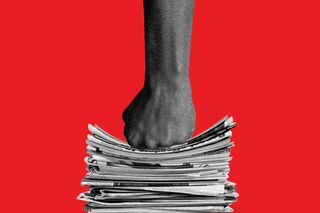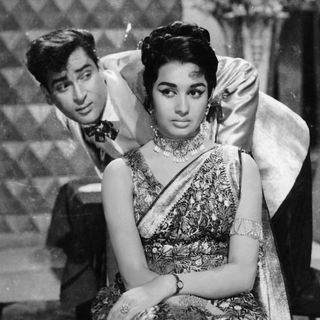
All the Arguments You Need: to Convince People They Need a Free Media
There’s more at stake than your favorite TV show.

The Indian government announced Wednesday it will bring OTT platforms such as Netflix, Amazon Prime Video and Hotstar, and online news portals within the purview of the country’s Information and Broadcasting Ministry. The move sent social media users into an uproar, with users expressing fear that popular shows would be censored or dropped for being ‘un-Indian.’ But there’s a graver potential threat in this order — the regulation of digital media, which includes digital publications as well as social media, through pages on Facebook, Twitter, and Instagram.
The current order merely assigns a department within the governmentresponsibility for digital news, which does not by itself mean the digital news industry has been brought under regulation. But experts still express concern that moves to assert regulatory authority could be the next step, as has been the department’s history.In essence, this could limit what journalists, at both traditional and social media news outlets, can report on. And if censorship of print journalism is any indication, this could turn into one of the biggest media suppression tactics ever kickstarted in the country.
Press freedom in India has been under attack for quite a while now, and this can potentially be one more nail in the coffin of the democratic ideal of a free and fair press in the country. It’s more imperative than ever to advocate for press freedom and ensure those who jeopardize it are held accountable. Here’s where you can start.
Indian journalism is full of propaganda. It’s all bought.
Wrong. When the idea of a bought media surfaces, there are always a choice few contenders who spout state-sanctioned propaganda and continue to get cited to justify the corruption of the entire industry. But in the age of online media, we see the news is much more democratized, and not just the ambit of a few traditional organizations. From journalists working for Instagram news pages or digital magazine start-ups to older, established publications, they’re sticking their necks out to bring the public the news — everything from how to understand the budget to traversing small alleyways and getting on-the-ground voices during the NRC-CAA protests.
They’re also getting injured in the process and/or sued by government-affiliated actors while continuing to do the work — from the hinterlands to the main cities — of bringing on-ground realities to light. If you think media is all bought, you may need to expand the news outlets you consume.
What censorship are you talking about? The media says whatever it wants to anyway.
Censorship doesn’t necessarily mean shutting down publications, or stripping journalists the right to report or speak their mind, atleast in democracies that are still holding on barely, like India’s. It happens in subtle, surreptitious ways, manifesting as a gradual onslaught on what journalists can or can’t cover, what they can or can’t say, and who they can or can’t hold accountable.
India ranks 142nd out of 180 countries on the World Press Freedom Index, which makes it among the world’s worst places to be a journalist. Journalists in India deal with harassment and assault on a daily basis, oftentimes from law enforcement. Government institutions also employ legal harassment tactics to threaten journalists for the work they do, including suing them, or arresting them, which is widely considered a media suppression tactic.
Related on The Swaddle:
All The Arguments You Need: to Convince People to Care About Digital Privacy
This hostile environment has resulted in a chilling effect on the press, in which journalists employ self-censorship as a way to ward off harm to themselves. And the harm is immense — at least 36 journalists have been murdered for their work in India since 1992, and all cases except two are still open, with no investigation, resolution, or conviction.
“Murder is really the highest form of censorship,” CPJ researcher for Asia, Aliya Iftikhar, tells Newslaundry. “… that sets a really alarming precedent.”
I get all of my news from social media. I don’t care about these institutions.
The latest order includes social media pages that act as activism or news pages as well. Also, what people consider the information they get simply from scrolling on social media is curated, produced by journalists — it’s simply disseminated on social media.So even if these Facebook pages weren’t included in the order (which they are), the news producers people access via Facebook are still being regulated, which means so is the news. Advocating for press freedom doesn’t just mean keeping safe anchors on television or investigative reporters with bylines in famous publications — it also means protecting those who, even on a small level, are trying to report current events and the administrator of your favorite social media page.
We live in a post-truth world. What can the news even change?
A lot. Take the NRC-CAA protests from earlier this year, for example. A movement that started in a choice few universities quickly snowballed into a country-wide resistance, partly because of the unrelenting, tireless coverage from journalists — both at traditional and at smaller online media offshoots. History shows media coverage can influence elections, change the course of political movements, and empower people with information that helps a citizenry make better decisions.
As the democratization of the press leads to more and more journalists dedicated to covering social and political movements — no matter how antithetical to any governmental regime — their right to free speech becomes even more imperative to protect. The decline in press freedom we’re seeing in India now, incidentally, is also one of the first factors that signal the death of democracy, which proves the crucial role a free press plays in the protection of democratic ideals, and in turn, your rights.
Rajvi Desai is The Swaddle's Culture Editor. After graduating from NYU as a Journalism and Politics major, she covered breaking news and politics in New York City, and dabbled in design and entertainment journalism. Back in the homeland, she's interested in tackling beauty, sports, politics and human rights in her gender-focused writing, while also co-managing The Swaddle Team's podcast, Respectfully Disagree.
Related


Woe Is Me! “I Feel Guilty When I Date, Thanks to Indian Culture”
